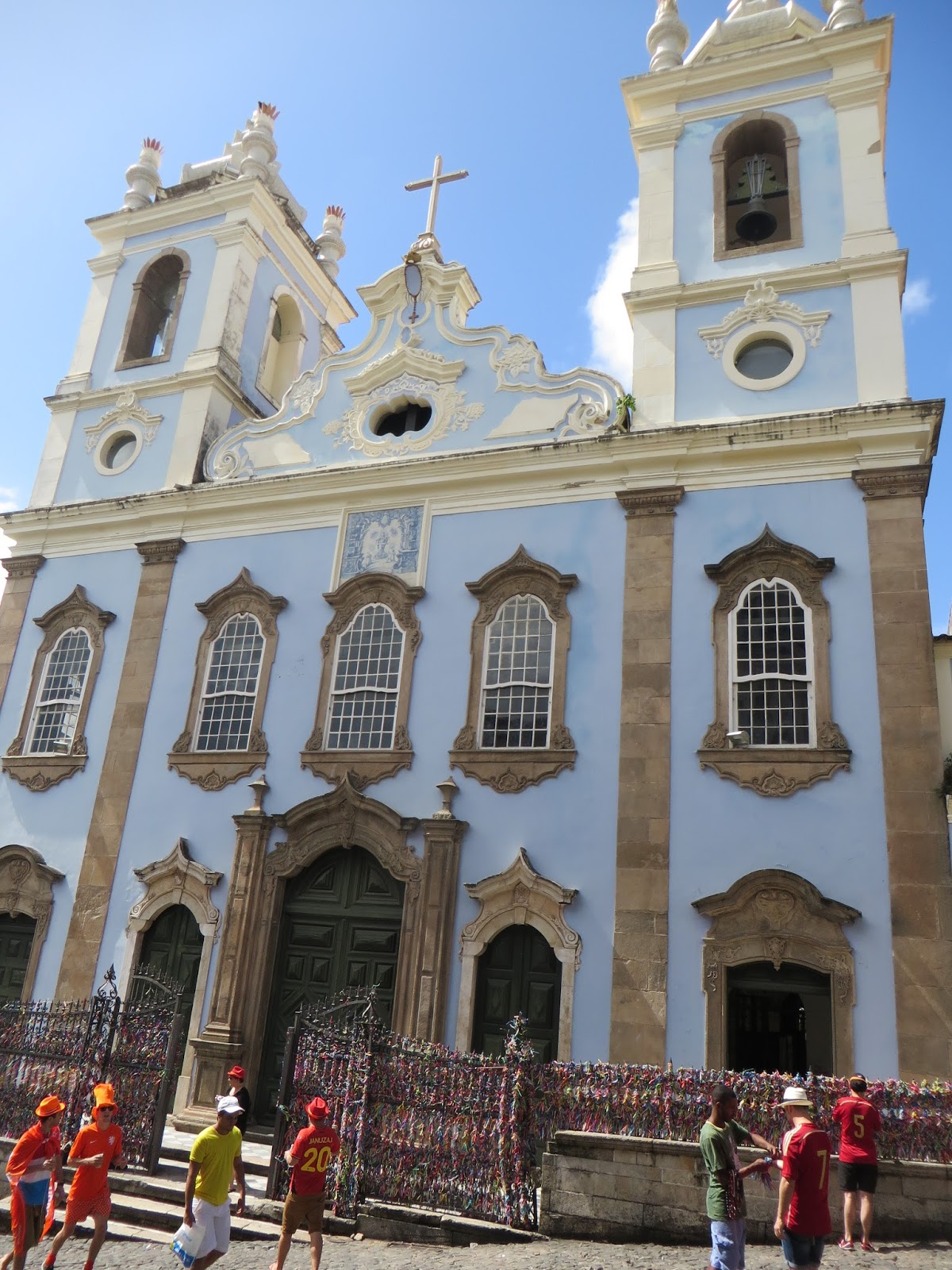We based ourselves in Salvador for the duration of the FIFA World Cup group games with a stadium ticket including a second round game and accommodation at Pousada Manga Rosa on the Barra waterfront. The Pousada (boutique hotel) is right on the waterfront, a perfect spot for the town beach, restaurants and bars.
Founded in 1549 as it's first capital Salvador remained Brazil's most important city for over three hundred years. The wealth that this brought is visible in the gold filled churches throughout the old city. From the foundation Salvador was built on transportation of slaves and has retained it's African influences of music, dance and arts. Salvador remains one of Brazil's most vibrant cities with a feel very different feel than the south of the country.
 |
| Igraja do Santissimo Sacramento do Passo |
On the way to the Pousada we had to negotiate several roadworks and it soon became apparent that infrastructure improvements that had been planned for the World Cup were still underway. Over the next few days we were saddened that the business at the Forte Sao Diogo end of Praia de Barra had barriers up with the street being dug up in different places every day, the view being obscured by diggers and a constant hum of pneumatic drill. Not the peaceful, scenic place we thought we had booked. There was no way we would spend time on the beach with such disruption.
The saddest thing of all was that every day huge progress was being made and you could see that with more organisation and planning it could have been beautiful. It has been incredibly frustrating as a tourist as what is clearly a lovely area has been quite unpleasant to walk around, must be even more frustrating for local businesses. Once finished the wide boulevard they are putting in will be superb and it must be hoped that the city and country benefits long term from infrastructure projects like this. A shame it is too late for the big event.
 |
| Once finished the Praia de Barra waterfront will be stunning. |
Our first trip to the Pelourinho, which is the old city was on the day of our first game. The Dutch fans had taken over the main square Terrerio de Jesus complete with live performers on stage.
The old city is a UNESCO World heritage site and it's steep, cobbled streets and colourful stone buildings, are great to wander around. With churches everywhere you turn I can see why it is said Salvador has a church for every day. As well as the World Cup our visit coincided with the Festival of Sao Joao (John the Baptist) so the streets were decorated with more than world cup bunting and frequent and random pyrotechnic explosions added to the mood. During the day it is a wonderful place to explore and soak up the atmosphere, though expect to see a lot of street vendors selling the usual tourist trinkets.
We found a small streetside restaurant for a pre game bite to eat, meat rice and beans, a staple of our diet in Brazil and only 12 Reais, we were able to watch Mexico v Cameroon to get us in the mood. Arriving at the stadium it encapsulated many of the concerns people have had over hosting the tournament here. The stunning 600 million real Fonte Nova Arena is overlooked by Favellas showing the stark contrast of hosting the event here. I will blog separately about the games themselves but in terms of organisation a few more signs directing people and at the first game a few more refreshment kiosks open were the only minor quibles.
 |
| Arena Fonte Nova |
 |
| Early on game day Netherlands v Espana |
Continuing along the Itapagipe peninsula we visited the beautiful. Igreja Nosso Senhor de Bonfim, the most important church in the Candomble religion. The iron railings are covered in thousands of Fitas, the seemingly omnipresent coloured ribbons which adorn wrists throughout Salvador. They are tied with three knots, each representing a wish which will come true by the time the ribbon falls off. Don't even think about cutting it! Services here are vibrant and melodic, very uplifting.
 |
| Igreja de Nosso Sehnor de Bonfim |
We watched the sunset over Baia De Todos Os Santos, the huge bay which Salvador sits on the mouth of and which creates (apparently) the only place in Brazil where the sun appears to set over the sea.
In Barra itself the city had chosen Farol de Barra as the site for the official FIFA Fan Fest ™ where big screens, musicians and a zip line entertained huge crowds on match days. I blogged previously (here ) on my disappointment that this site wasn't open every day but it was a perfect choice of venue and a complete success when open.
 |
| FIFA Fan Fest™ site viewed from Farol de Barra |
The Farol (lighthouse) itself sits atop Forte de Santo Antonio de Barra and is home to the city's nautical museum which contains interesting artifacts from the city's seafaring history including the slave trade and an interesting ships in bottles exhibit. How do they do that? Climbing to the top of the Farol gives a great panoramic view.
 |
| Forte de San Antonio de Barra |
There is so much more to Salvador, we loved seeing the city embrace the World Cup, we loved the old town and enjoyed the history. Yes there were missed opportunities and the continued construction work around Barra was a disappointment but long term that work will only improve what is a wonderful city to visit.






No comments:
Post a Comment